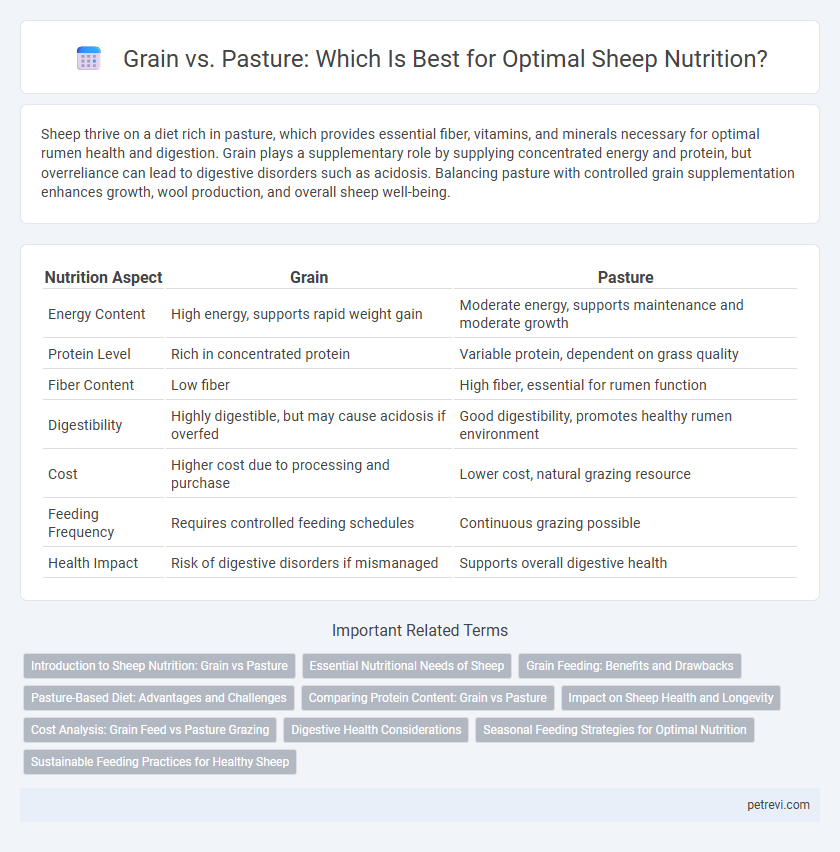Sheep thrive on a diet rich in pasture, which provides essential fiber, vitamins, and minerals necessary for optimal rumen health and digestion. Grain plays a supplementary role by supplying concentrated energy and protein, but overreliance can lead to digestive disorders such as acidosis. Balancing pasture with controlled grain supplementation enhances growth, wool production, and overall sheep well-being.
Table of Comparison
| Nutrition Aspect | Grain | Pasture |
|---|---|---|
| Energy Content | High energy, supports rapid weight gain | Moderate energy, supports maintenance and moderate growth |
| Protein Level | Rich in concentrated protein | Variable protein, dependent on grass quality |
| Fiber Content | Low fiber | High fiber, essential for rumen function |
| Digestibility | Highly digestible, but may cause acidosis if overfed | Good digestibility, promotes healthy rumen environment |
| Cost | Higher cost due to processing and purchase | Lower cost, natural grazing resource |
| Feeding Frequency | Requires controlled feeding schedules | Continuous grazing possible |
| Health Impact | Risk of digestive disorders if mismanaged | Supports overall digestive health |
Introduction to Sheep Nutrition: Grain vs Pasture
Pasture provides sheep with essential fiber, vitamins, and minerals critical for maintaining rumen health and natural grazing behavior, while grain offers a concentrated source of energy and protein ideal for rapid weight gain or supplementation. Balancing pasture and grain intake prevents digestive disorders such as acidosis and ensures optimal nutrient absorption for growth, reproduction, and wool production. Understanding the nutritional composition and appropriate ratios of grain and pasture supports efficient flock management and overall sheep well-being.
Essential Nutritional Needs of Sheep
Sheep require a balanced diet rich in protein, energy, fiber, vitamins, and minerals to support growth, reproduction, and wool production. Grain provides a concentrated source of energy and protein essential for high-producing animals but lacks adequate fiber, which is crucial for proper rumen function. Pasture offers natural forage abundant in fiber, vitamins A and E, and minerals like calcium and phosphorus, supporting digestion and overall health, making a combined feeding strategy optimal for meeting the essential nutritional needs of sheep.
Grain Feeding: Benefits and Drawbacks
Grain feeding in sheep nutrition provides a high-energy source that supports rapid weight gain and improved wool production, particularly during growth, finishing, or lactation stages. However, excessive grain intake can lead to digestive disorders such as acidosis, reducing overall health and productivity. Balancing grain with adequate forage promotes rumen function and minimizes risks associated with high-grain diets.
Pasture-Based Diet: Advantages and Challenges
Pasture-based diets for sheep provide natural forage rich in fiber, essential vitamins, and minerals promoting rumen health and optimal digestion. Grazing reduces feed costs and supports sustainable agriculture but exposes sheep to seasonal forage variability and parasite risks requiring strategic pasture management. Integrating rotational grazing and forage diversification enhances nutrient intake and mitigates challenges associated with pasture reliance.
Comparing Protein Content: Grain vs Pasture
Grain typically provides higher crude protein content, ranging from 12% to 18%, essential for muscle development and wool growth in sheep. Pasture protein content varies widely, often between 8% and 20%, depending on plant species, growth stage, and soil fertility, making fresh pasture a valuable protein source during peak growth periods. Balancing grain and pasture intake optimizes protein availability, supporting overall sheep health and production efficiency.
Impact on Sheep Health and Longevity
Feeding sheep primarily on pasture enhances rumen function and reduces the risk of acidosis compared to grain-based diets, promoting better digestive health and longevity. Pasture rich in diverse forages provides essential vitamins, minerals, and fiber, supporting immune function and reducing incidences of metabolic disorders. Grain supplementation, while energy-dense, can lead to imbalanced nutrition and increased fat deposition, potentially shortening productive lifespan and increasing susceptibility to diseases.
Cost Analysis: Grain Feed vs Pasture Grazing
Grain feed for sheep generally incurs higher costs due to purchase, storage, and transportation expenses, while pasture grazing primarily involves land management and maintenance costs, which can be significantly lower depending on regional forage availability. Economic analyses show that pasture grazing lowers feed expenses per sheep by reducing reliance on commercial feed, though quality and nutritional consistency can vary seasonally, potentially impacting growth rates and wool production. Cost-effective sheep nutrition strategies often balance supplemental grain feeding with pasture use to optimize productivity while managing overall feeding costs.
Digestive Health Considerations
Pasture provides essential fiber that supports optimal rumen function in sheep, promoting healthy microbial fermentation and preventing digestive disorders like acidosis. Grain diets, rich in starch, can lead to rapid fermentation and acid build-up, increasing the risk of ruminal acidosis and digestive upset if not carefully managed. Balancing grain with adequate forage ensures stable rumen pH and sustains nutrient absorption critical for sheep health and productivity.
Seasonal Feeding Strategies for Optimal Nutrition
Sheep require a balanced diet where pasture provides essential fiber and vitamins during spring and summer pasture growth peaks, promoting rumen health and weight gain. Grain supplementation becomes critical in winter and dry seasons when pasture quality declines, offering concentrated energy and protein to maintain body condition and support reproduction. Combining seasonal pasture grazing with targeted grain feeding optimizes nutrient intake, improves sheep growth rates, and reduces feed costs year-round.
Sustainable Feeding Practices for Healthy Sheep
Sheep nutrition thrives on a balance between grain and pasture, with pasture providing essential fiber and natural nutrients that promote rumen health and reduce digestive disorders. Sustainable feeding practices emphasize pasture-based diets supplemented with modest grain quantities to enhance energy intake without compromising animal welfare or environmental health. Integrating rotational grazing and nutrient-rich forage supports metabolic efficiency, boosts immune function, and decreases reliance on external feed inputs, ensuring long-term flock vitality.
Grain vs Pasture for Sheep Nutrition Infographic

 petrevi.com
petrevi.com